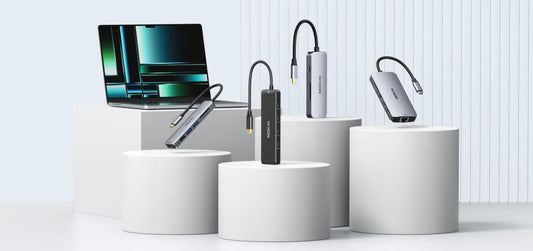Discover Differences between SST and MST / Unlocking the Secrets: SST Mode vs. MST Mode in Hubs
Contents
What is SST ?
——————————

Single-stream transport, a technology rooted in the DisplayPort standard, allows the connection of an external downstream device via a single port. However, SST can allow the second external screen to display the same image as the first screen. SST is commonly used in scenarios where the same content needs to be displayed across different screens simultaneously.
In SST mode, graphical output is replicated across multiple screens, ensuring that the content is identical on each display. This mode is useful when visual output needs to be consistent. For example, specific information needs to be conveyed to multiple audiences at the same time during a meeting. SST simplifies the setup process by ensuring that all external displays show the same content without the need for adjustments on each screen.
What is MST ?
——————————

Multi-stream transport was initially presented as a feature of the DisplayPort 1.2 standard. It enables the connection of numerous external displays through a DP port on the source device. It achieves this by combining several video streams into a unified stream, which is then sent to a branch device. This device subsequently breaks down the signal back into the initial streams for display on the respective screens.
Branch devices typically include MST hubs or docks that connect to a single DP input port and offer multiple output options. In addition, they can be integrated into a display itself to create a DP output port for daisy-chaining, essentially incorporating a 2-port MST hub within the display.

Standard DisplayPort input ports commonly found on most displays cannot function as daisy-chain outputs. Only the last display in the daisy chain does not need to support this feature or have a DP output port specifically. Additionally, the DisplayPort 1.1 display can connect to MST hubs and be part of a daisy chain if it is the final display in the sequence.

The software of the host system needs to support MST for hubs or daisy chains to work. While Windows supports for it, Apple operating systems currently do not support MST display mode or DisplayPort daisy-chaining.
The USB Type-C DisplayPort Alternate Mode supports MST, so standard DisplayPort daisy chains and MST hubs can be run from a Type-C source via a simple Type-C to DisplayPort adapter.
Here's a link to various MOKiN hubs and docking stations designed to optimize laptops that utilize MST mode for connecting external displays.
Benefits of Multi-Stream Transport Mode
——————————

For professionals like programmers, video editors, and graphic designers, the use of multiple displays is a common practice. MST mode significantly enhances multitasking abilities, allowing them to engage in communication, view graphical trends, or conduct video across extra screens while focusing on their primary work screen. MST mode not only boosts work efficiency but also streamlines workflows, ultimately saving valuable time. The immersive work environment provided by the MST display further enhances the user experience.
MST display significantly reduces setup expenses due to its streamlined single-cable design. In the past, connecting the source to the monitors required numerous expensive, high-quality display cables. With MST, only a single cable connection from the source to the extra display screens is needed, effectively cutting down on setup costs and simplifying cable management.
Tips for MST Use
——————————
Verify that your hub comes with a sufficient power supply to accommodate all linked devices. Adequate power ensures a reliable connection and higher performance.
Confirm the hub's compatibility with your devices, particularly when connecting multiple monitors or high-resolution displays. Ensure that your devices support MST mode. A non-compatible monitor will not display or may not feature an output DP port for daisy-chaining configuration.
Take into consideration the bandwidth restrictions of the hub. Linking several high-resolution displays could demand greater bandwidth than what the hub can offer, resulting in reduced performance.
Verify any essential driver updates for the hub to guarantee compatibility with your operating system and devices. Check for firmware updates for the hub and install them as required to ensure the hub is running the latest software for peak performance and adaptability.
It's vital to use high-quality DP 1.2, USB-C, or Thunderbolt 4 cables to avoid recognition issues. Ensure cables are certified and of good build quality. A substandard hub or docking station can limit the bandwidth, leading to lower resolution and refresh rates. Use an adapter from a reputed organization.
Please pay attention to the temperature of your hub when using it, especially when multiple devices are connected at once. Excessive heat may affect the hub.
When removing devices from the hub, ensure that they are properly disconnected from the operating system to avoid potential damage to the device.
Applications of MST
——————————
✅ Professional Workstations: Video editing, graphic design, and engineering utilize multi-screen setups to enhance their working capabilities. The presence of more workspace enables them to perform their tasks efficiently. MST mode is also useful for presenters who need to share content on several screens during meetings, providing a more dynamic visual experience for the audience.
✅ Gaming and Entertainment: Gaming and multimedia enthusiasts are usually the first to utilize MST mode to enrich their experience or media content across multiple monitors.
✅ Digital Signage: MST mode can be utilized to showcase content simultaneously across multiple screens for advertising.
✅ Education and Training: In educational settings, MST mode can be adopted to create an interactive learning atmosphere by displaying different educational content on separate screens. Auditoriums and classrooms utilize multi-stream transmission to ensure that large displays have mirroring, extending and video wall capabilities. For home cinema setups, Video walls are of better quality with no shadows or blurring.
✅ Monitoring and Surveillance: In surveillance systems, MST enables the display of signals from different cameras on individual screens.
Our Recommend Product
MOUC0231:13 IN 1 USB C Multifunctional Docking Station
MOUC3310:11 IN 1 Dual Monitor USB C Docking Station
MOUC3702:12 IN 1 USB C Docking Station With 3 Monitors
YOU MAY ALSO LIKE
MacBook Accessories Guide: What to Buy and Why
Understanding iPhone Charging Ports: From Lightning to USB-C

MOKiN 13-IN-1 USB-C Laptop Charging Station with 2.26-inch LCD Smart Display








